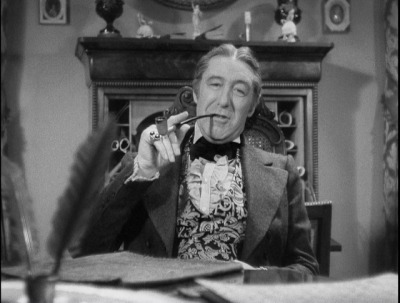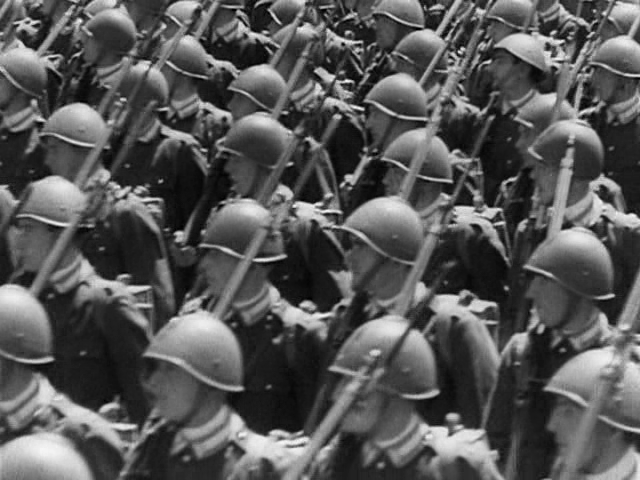*Atenção: No IMDb o título do filme é “A Marcha
dos Séculos”. Entretanto, ele foi exibido na televisão como “E o Mundo Marcha”*
Vez ou outra encontro um filme em preto e branco
na TV a cabo e, não importa seu enredo ou seus protagonistas, sempre o assisto.
E vez ou outra este filme surpresa se transforma, em frente aos meus olhos, em
uma obra-prima desconhecida e menosprezada. “E o Mundo Marcha” só é lembrado
por ter sido o primeiro filme aprovado pelo Código Hays (está lá o selo número
1 no começo da película), mas este belo trabalho de John Ford merece muito mais
reconhecimento.
Every now and then, I
find a black and white film on cable TV and, no matter the story or the leads,
I watch it. And every now and then this surprise film becomes, in front of my
eyes, in an unknown and underrated masterpiece. “The World Moves On” is only
rememberd as the first film approved by the Hays Office (the seal with the
number 1 is there in the beginning of the film”, but this beautiful film by
John Ford deserves a lot more recognition.
Só o nome de John Ford já anuncia que estamos
prestes a ver algo muito bom. E a história dividida em fases não decepciona. No
início do século XIX, as famílias Warburton e Girard se unem no negócio do
algodão. O marido de Mary Warburton (Madeleine Carroll) se torna sócio de
Richard Girard (Franchot Tone), mas Mary e Richard se apaixonam. Quase um
século se passa até que esse amor possa ser consumado através dos bisnetos de
Mary e Richard, que “por acaso” têm o mesmo nome dos antepassados e são
interpretados pelos mesmos atores. Até então o negócio do algodão foi um
sucesso total, mas tempos tempestuosos estão por vir.
John
Ford’s name alone announces that we’re about to see something very good. And
the story that is divided in phases does not disappoint. In the beginning of
the 19th century, the families Warburton and Girard make a
partnership to sell cotton. Mary Warburton’s (Madeleine Carroll) husband
becomes partners with Richard Girard (Franchot Tone), but Mary and Richard fall
in love. Almost a century goes by until this love can be consummated through
Mary’s and Richard’s great-grandkids, who “by chance” have the same name as
them and are played by the same actors. Until then the cotton business had been
going well, but bad times are coming.
Um fortuito detalhe do enredo: o negócio de
algodão é comandado por diversos herdeiros, cada um vivendo em um país afetado
pela Primeira Guerra Mundial. Temos percepções diferentes dos campos de batalha
e da luta dentro dos exércitos francês, inglês, americano e alemão. O ator que
interpreta Henri Girard, aliás, é o brasileiro Raul Roulien, que John Ford
considerava “meu amigo e grande ator”.
An interesting
detail in the plot: the cotton business is managed by several heirs, each one
living in a country affected by World War I. Because of this we have different
perceptions of the battle field and the fights inside the French, English,
American and German armies. The actor who plays Henri Girard, by the way, is
the Brazilian Raul Roulien, who John Ford considered “my friend and great actor”.
Todo e qualquer espectador fica boquiaberto nos
minutos finais do filme, quando John Ford prevê a Segunda Guerra Mundial – com
uma marcha de suásticas e tudo o mais. Serão tempos difíceis, prevê a
personagem de Madeleine Carroll.
Each and
all viewers become speechless in the final minutes of the film, when John Ford
predicts World War II – with a march full of swastikas. These will be difficult
times, and Madeleine Carroll’s character predicts.
Há, sim, um detalhe que mancha o filme, e não
posso deixar de citá-lo: o tratamento do personagem Dixie (Stepin Fetchit) é
muito, muito racista. O pobre negro não é nada inteligente, e por isso sempre
está envolvido em confusões. Obviamente, a intenção original era usar o
personagem como contraponto cômico em meio ao drama, mas aqui John Ford cometeu
um grande erro. Em 1934 o personagem poderia ter sido engraçado (e ele até é
divertido ainda hoje, porém causa mais vergonha que riso), mas o tempo e as
novas ideias de igualdade e respeito mancharam este aspecto do enredo. Só que
Stepin Fetchit pouco importava com as reações contra sua persona
cinematográfica: parceiro constante de John Ford, foi o primeiro ator negro de
cinema a ficar milionário.
There
is a negative detail in the film, and I have to mention it: the treatment of
the character Dixie (Stepin Fetchit) is very, very racist. The poor black man
is not intelligent, and gets involved in many troubles because of it.
Obviously, the original intention was to use the character as a comic relief in
the middle of so much drama, but John Ford made a huge mistake. In 1934 the
character could have been funny (and he is kinda funny even today, but now he
generates more shame than laugh), but time and new widespread ideas of equality
and respect stained this detail of the film. But Stepin Fetchit didn’t really
care about the reactions against his film persona: a constant in John Ford’s
stock company, he was the first black actor to become a millionaire.
| Raul Roulien e Stepin Fetchit |
É o melhor filme de algum dos envolvidos?
Definitivamente não. Madeleine Carroll fez “Os 39 Degraus / The 39 Steps” em
1935, mesmo ano em que Franchot Tone esteve em “O Grande Motim / Mutiny on the
Bounty” e “Perigosa / Dangerous”. John Ford esteve envolvido na confecção de
uma dúzia de clássicos, e por isso é até compreensível a mínima atenção dada a
este filme.
Is this
the best film of any of the involved cast? Not at all. Madeleine Carroll did “The
39 Steps” in 1935, the same year when Franchot Tone did “Mutiny on the Bounty”
and “Dangerous”. John Ford was involved in the making of a dozen classics, and
that’s why we can understand the little attention given to this film.
Para Peter Bogdanovich, John Ford confessou que
gostaria de esquecer que fez “E o Mundo Marcha”. Ele não queria dirigir o
filme. Brigou, discutiu, ganhou a fama de durão, e não escapou. A Fox o obrigou
a dirigir a película, pois a intenção era repetir o sucesso de “Cavalgada /
Cavalcade”, Oscar de Melhor Filme de 1933 que também contava a saga de uma
família durante muitas gerações e vários conflitos. Não havia sobrado
criatividade para o roteirista Reginald Berkeley, e o resultado são diálogos e
situações que não ficam muito tempo na nossa memória.
To
Peter Bogdanovich, John Ford confessed that he’d like to forget that he did “The
World Moves On”. He didn’t want to direct the movie. He fought, argued, became known
as a tough guy, and had to do it anyway. Fox made him direct the film, because
they wanted to repeat the success of “Cavalcade”, the 1933 Best Picture Winner
that also told the story of a family through several generations and many
conflicts. There was not much creativity left for screenwriter Reginald
Berkeley, and the result are dialogs and a situations that don’t stay long in
our memories.
O que fica são as cenas
de guerra, que causam um estranho déjà vu até no espectador mais jovem. Associei as cenas com “O Grande Desfile/ The Big Parade” (1925), mas a fonte era outra: as elogiadas cenas de batalha
eram nada mais que cenas não utilizadas de “Cruzes de Madeira”, filme francês
de 1932.
What
stay with us is the war scenes, that cause a strange déjà vu even in the
youngest viewer. I associated the scenes with “The Big Parade” (1925), but the
source was different: the great battle scenes were only unused footage from “Wooden
Crosses”, a French film made in 1932.
Madeleine Carroll, emprestada ao estúdio Fox em
seu primeiro trabalho nos Estados Unidos, estava mais interessada no diretor
Ford que no filme em si. John Ford preferiu esquecer esta sua obra. Franchot
Tone não parece ter comentado sobre ela. O filme foi um fracasso de bilheteria,
mas surpreende quem hoje, oitenta anos após ser filmado, lhe dá uma chance de
mostrar a que veio. Porque até o pior filme de John Ford é excelente.
Madeleine
Carroll, loaned to Fox in her first work in the US, was more interested in
director Ford than in the film itself. John Ford preferred to forget this work.
It looks like Franchot Tone never said anything about it. The film was a
box-office failure, but it surprises whoever gives it a try today, eighty years
after it was filmed. Because even John Ford’s wors movie is excellent.
This
is my contribution to the Madeleine Carroll blogathon, hosted by
Dorian at Tales of the Easily Distracted and Ruth at Silver Screenings!








10 comments:
Thanks for providing all this background info, Le. I had never heard of this film before, and was surprised to learn it was directed by John Ford.
I agree with you – I'd much rather watch a poor John Ford film than many, MANY other movies.
Thanks for joining our blogathon! :)
eu tb tenho costume de ver filmes que nunca ouvi falar. e esse problema de títulos diferentes confunde. dependendo da época tem um nome. no cinema às vezes vai com um. no dvd com outro. como tenho um amigo português que me visita no blog sempre coloco o original para ele se achar. anotado esse filme. beijos, pedrita
I am very curious to see this early Ford film. Thank you for the interesting history.
I'd be very interested to see this, and am surprised to hear it predicts WW2. I'll take warning about the racial stereotyping. Good piece, as usual!
Oh, this looks like a gem! I think this is often considered to be Ford's 'worst' film (I guess everyone has to have one!) but it sounds like it's worth a watch, even if for the historical interest.
Thank you for reviewing this film - it sounds like one I would like to see. Great choice - you really sparked everyone's interest!
Olá Letícia, fiquei muito curiosa e com vontade de ver este filme. A Fotografia pelo que vi é deslumbrante e o enredo ..hummm fo jeito que eu aprecio.
Mais um que vou anotar na minha lista de raridades para se ver. Vou caçar até encontrar.
Belo texto, adorei.
Beijos e Parabéns!
Le, thanks for discovery of this hard-to-find early John Ford film from John Ford and THE WORLD GOES ON! True, the Stepin Fetchit characters seem in bad taste today, but he had to eat too, and you can't blame people for NOT being ahead of their time. In any case, your post was very well done, as always! :-D Thanks for joining the Madeleine Carroll Blogathon! :-D
Também sou do tipo que se estiver passando um filme antigo, ainda mais em p&b, não importa qual seja eu paro pra assistir, rsrs. Fiquei curiosa pra ver esse filme =)
Beijos, Pri
VINTAGEPRI
Adoro filmes que se passam no sul dos EUA durante o século XIX. Sei que é uma parte que muitos preferem esquecer por causa da escravidão... os filmes antigos exploram bem o cenário com enredos românticos, dramáticos e meio "novelescos". Assim é E o Vento Levou, não é mesmo?
Amei o post!
Beijos <3
Post a Comment